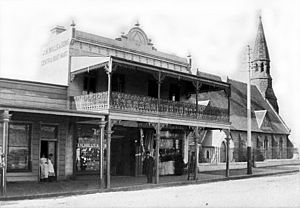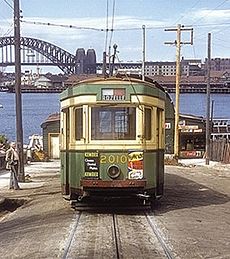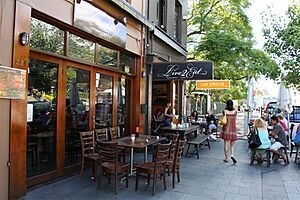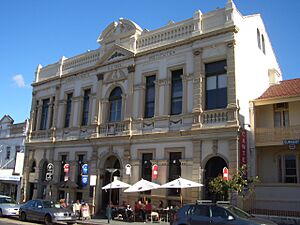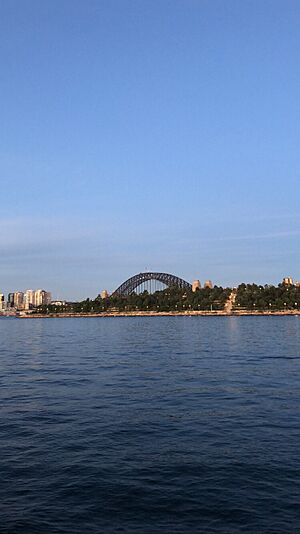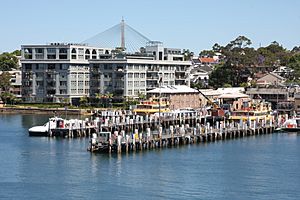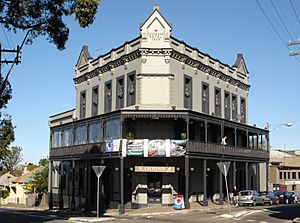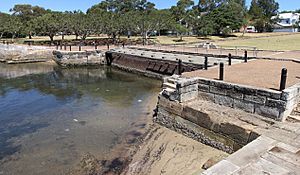Balmain, New South Wales facts for kids
Quick facts for kids BalmainSydney, New South Wales |
|||||||||||||||
|---|---|---|---|---|---|---|---|---|---|---|---|---|---|---|---|
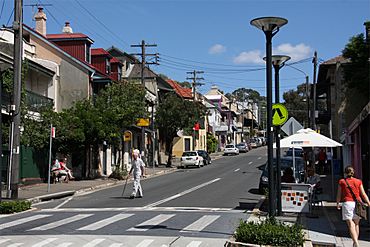
Darling Street
|
|||||||||||||||
| Established | 1836 | ||||||||||||||
| Postcode(s) | 2041 | ||||||||||||||
| Elevation | 49 m (161 ft) | ||||||||||||||
| Area | 1.5 km2 (0.6 sq mi) | ||||||||||||||
| Location | 5 km (3 mi) west of Sydney CBD | ||||||||||||||
| LGA(s) | Inner West Council | ||||||||||||||
| State electorate(s) | Balmain | ||||||||||||||
| Federal Division(s) | Grayndler | ||||||||||||||
|
|||||||||||||||
Balmain is a lively suburb in the Inner West of Sydney, New South Wales, Australia. It's located about 2 kilometers (1.2 miles) west of the Sydney central business district (CBD). Balmain is part of the Inner West Council area.
This suburb sits on the Balmain peninsula, surrounded by Port Jackson. It's next to Rozelle to the south-west, Birchgrove to the north-west, and Balmain East to the east. Iron Cove is on the west side, White Bay on the south-east, and Mort Bay on the north-east.
Balmain was once a place where many factory and dock workers lived. It's famous in Australian history because the Australian Labor Party (a major political party) was formed here in 1891. Today, the Australian Greens and the Labor Party are the main political groups in Balmain.
Contents
Balmain's Story: A Look Back
Before Europeans arrived, the Aboriginal Gadigal and Wangal people lived here. They used to hunt kangaroos by guiding them down to Peacock Point.
The land that is now Balmain was given to a surgeon named William Balmain in 1800. He later transferred the land to John Borthwick Gilchrist. For many years, there were legal arguments about who owned the land. During this time, the land was used for farming.
In 1836, the land was divided into smaller blocks. Balmain grew quickly in the 1840s. By 1861, it had become a busy area.
Busy Industries and Docks
The Balmain peninsula quickly became a major industrial hub in Sydney during the 1800s. Many factories and workshops were built around Mort Bay. These included places for shipbuilding, metalwork, and engineering.
The Mort's Dock & Engineering Company opened in 1855. This dock was very important for building and repairing ships. It closed in 1958, and now it's a park called Mort Bay Park.
The growth of industries meant many workers needed homes. Small cottages were built for them. The Lever Brothers Factory, which made soap, opened in 1895.
The Balmain Coal Mine
A coal mine opened in Balmain in 1897. It was located near Birchgrove Public School. The mine had a very large winding engine.
Coal was found under the harbour, between Ballast Point and Goat Island. Because of this coal, the Balmain Power Station was built starting in 1909. The mine closed in 1931 after many worker disputes.
Trams and Changes
In the 1920s, a tramway opened in Balmain. This helped the area grow. Balmain became known as a working-class area. In the 1950s, many immigrants moved to Balmain, increasing its population.
Balmain Today: A Modern Suburb
Starting in the 1960s, Balmain began to change. As industries closed, more middle-class people moved in. This process is called gentrification. Balmain became a popular place to live because it's by the water and close to Sydney's city center.
Many old industrial sites have been turned into apartments. For example, the Lever Brothers factory became apartments in 1996. The old power station was also demolished for apartments in 1998. However, many parts of Balmain's industrial past are still protected as heritage sites.
Historic Places to See
Balmain has many places listed for their historical importance. These include:
- 1 Blake Street: Ewenton
- Booth Street: Balmain Hospital Main Building
- Glassop Street: Dawn Fraser Swimming Pool
- 12b Grafton Street: Hampton Villa
- 37 Nicholson Street: Waterview Wharf Workshops
- Thames, Mort, College, McKell, Cameron, Yeend Streets: Mort's Dock
- 2 Wells Street: Louisaville
Who Lives in Balmain?
At the 2021 census, Balmain had a population of 10,454 people. Most people (64.8%) were born in Australia. Other common birthplaces include England (9.1%) and New Zealand (2.8%).
English is spoken at home by 83.4% of people. Other languages include Mandarin and Italian. Many people in Balmain (51.9%) say they have no religion. Most homes are flats, units, or townhouses.
Shopping and Dining
Darling Street is Balmain's main street. It's full of unique shops, great restaurants, and cafes. You can also find old pubs there. Important buildings on Darling Street include the Post Office, Court House, and Balmain Town Hall.
The NSW Water Police headquarters moved to Cameron Cove in Balmain in 2007.
Getting Around Balmain
Balmain has several ferry wharves. These include Thames Street Balmain, Elliot Street Balmain West, and Darling Street Balmain East. Ferries connect Balmain to Circular Quay. The company that runs the ferries also has its maintenance base at Balmain Shipyard.
The main roads in Balmain are Darling Street, Beattie Street, and Montague/Mullen Street. Trams used to run down Darling Street to the wharf. They used a special "dummy" counterweight system to go up and down the very steep hill safely.
Today, you can catch Transit Systems buses in Balmain. These include routes to Railway Square, Art Gallery of New South Wales, Queen Victoria Building, and Campsie.
Fun Facts and Culture
The "Balmain bug" (Ibacus peronii) is a type of lobster often eaten in Sydney. It's named after Balmain!
Historic Pubs
Balmain is famous for its many old pubs. Some of these include the Cat and Fiddle Hotel, Cricketer's Arms Hotel, Dry Dock Hotel, and Royal Oak Hotel.
The Riverview Hotel was built in 1880. The famous Australian swimmer Dawn Fraser was the publican (manager) of the Riverview from 1978 to 1983.
Balmain in Pop Culture
Balmain has been mentioned in many famous sayings. Former NSW Premier Neville Wran once said, "Balmain boys don't cry." Another saying is, "You can take the boy out of Balmain, but you can't take Balmain out of the boy."
In the 1960s, the TV show My Name's McGooley, What's Yours? was set in Balmain. The 1994 Australian film The Sum of Us, starring Russell Crowe, was also filmed here. The TV soap opera E Street used the former Pacific Hotel and other Balmain locations as sets.
Parks and Green Spaces
Balmain has several parks, like Gladstone Park, Birrung Park, and White Bay Park. There are many more parks nearby, especially along the waterfront.
Sports and Recreation
Balmain is home to the Balmain Tigers rugby league club. They are now part of the Wests Tigers team in the NRL. In 2005, the Wests Tigers won the premiership!
The Balmain Rugby Football Club was founded in 1873. They won their first championship in 1875. The club later merged and is now known as the Drummoyne District Rugby Football Club.
Balmain also has the Balmain Australian Football Club, which started in 1903. The Balmain FC is a semi-professional football (soccer) club. In 2015, they played against the A-League club Melbourne Victory FC in the FFA Cup.
The Balmain Sailing Club is nearby in Birchgrove. It hosts the yearly Balmain Regatta. The Balmain Rowing Club was formed in 1882 and is still in its original location.
Homes in Balmain
Balmain has many charming and interesting houses. Many of them are Victorian and Edwardian style homes. Because of its history and location, houses in Balmain can be quite expensive.
Some famous architects have designed homes here. For example, a house designed by Harry Seidler sold for $6 million in 2013. The Tom Uren House was designed by Richard Leplastrier.
Famous People from Balmain
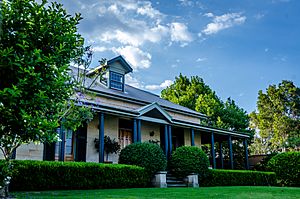
Many notable people have lived in Balmain, including:
- Rose Byrne, actress
- Dawn Fraser, champion swimmer and politician
- Billy Hughes, 7th Prime Minister of Australia
- Archie Jackson, Australian cricketer
- Alex Lloyd, singer/songwriter
- Dally Messenger, rugby union & rugby league player
- Matthew Mitcham, diver
- Frank Moorhouse, author
- George Negus, journalist
- Henry Parkes, 7th Premier of New South Wales
- Wayne Pearce, former professional rugby league player
- Josh Pyke, musician
- Rick Springfield, singer-songwriter and actor
- Tom Uren, former government minister
- Neville Wran, 35th Premier of New South Wales
- Malcolm Young, musician (from the band AC/DC)
Images for kids



